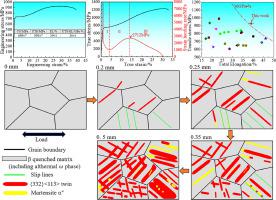当前位置:
X-MOL 学术
›
J. Mater. Sci. Technol.
›
论文详情
Our official English website, www.x-mol.net, welcomes your feedback! (Note: you will need to create a separate account there.)
In-situ deformation mechanisms of a novel Ti-5Mo-4Cr-1V-1Zr metastable β titanium alloy
Journal of Materials Science & Technology ( IF 11.2 ) Pub Date : 2024-06-22 , DOI: 10.1016/j.jmst.2024.05.059 Shuai Zhao , Yang Wang , Chengran Chai , Rong Ran , Lin Peng , Yuanxiang Zhang , Feng Fang , Guo Yuan
Journal of Materials Science & Technology ( IF 11.2 ) Pub Date : 2024-06-22 , DOI: 10.1016/j.jmst.2024.05.059 Shuai Zhao , Yang Wang , Chengran Chai , Rong Ran , Lin Peng , Yuanxiang Zhang , Feng Fang , Guo Yuan

|
To overcome the strength-plasticity trade-off in the structural titanium alloys, a novel metastable β titanium alloy Ti-5Mo-4Cr-1V-1Zr (Ti-5411) with high strength and high plasticity was designed by the -electrons theory, average electron-to-atom ratio () and atomic radius difference () theory. Combined in-situ scanning electron microscope (SEM) and electron backscatter diffraction (EBSD), the deformation mechanisms of the novel Ti-5411 metastable β titanium alloy were systematically investigated. The results show that the Ti-5411 alloy exhibits excellent yield strength (∼689 MPa), tensile strength (∼930 MPa) and total elongation (∼39%). The in-situ tension indicates that slip activities, crystal rotation, stress induced martensite (SIM) α″ transformation and {332}<113> deformation twin are the major deformation mechanisms of Ti-5411 alloy. Besides, with the increase of strain degree (0–0.5 mm displacement), deformation twins increase, widen and interlace. At 0.35 mm tensile displacement, the orientation of the β grains rotates ∼6.65° to accommodate the increased macrostrain. Additionally, martensite α″ also assists the nucleation of twins. Some {332}<113> twins grow and merge by consuming martensite α″ during deformation, and the residual martensite α″ remains in the merged twins.
中文翻译:

新型Ti-5Mo-4Cr-1V-1Zr亚稳β钛合金的原位变形机制
为了克服结构钛合金的强度-塑性权衡问题,利用电子理论,平均设计了一种具有高强度和高塑性的新型亚稳态β钛合金Ti-5Mo-4Cr-1V-1Zr(Ti-5411)电子原子比()和原子半径差()理论。结合原位扫描电子显微镜(SEM)和电子背散射衍射(EBSD),系统研究了新型Ti-5411亚稳β钛合金的变形机制。结果表明,Ti-5411 合金具有优异的屈服强度(~689 MPa)、抗拉强度(~930 MPa)和总伸长率(~39%)。原位张力表明滑移活动、晶体旋转、应力诱导马氏体(SIM)α”相变和{332}<113>变形孪晶是Ti-5411合金的主要变形机制。此外,随着应变程度(0~0.5 mm位移)的增加,变形孪晶增多、变宽、交错。在 0.35 mm 拉伸位移下,β 晶粒的方向旋转约 6.65° 以适应增加的宏观应变。此外,马氏体α”也有助于孪晶的形核。一些{332}<113>孪晶在变形过程中通过消耗马氏体α”而生长并合并,而残余马氏体α”保留在合并孪晶中。
更新日期:2024-06-22
中文翻译:

新型Ti-5Mo-4Cr-1V-1Zr亚稳β钛合金的原位变形机制
为了克服结构钛合金的强度-塑性权衡问题,利用电子理论,平均设计了一种具有高强度和高塑性的新型亚稳态β钛合金Ti-5Mo-4Cr-1V-1Zr(Ti-5411)电子原子比()和原子半径差()理论。结合原位扫描电子显微镜(SEM)和电子背散射衍射(EBSD),系统研究了新型Ti-5411亚稳β钛合金的变形机制。结果表明,Ti-5411 合金具有优异的屈服强度(~689 MPa)、抗拉强度(~930 MPa)和总伸长率(~39%)。原位张力表明滑移活动、晶体旋转、应力诱导马氏体(SIM)α”相变和{332}<113>变形孪晶是Ti-5411合金的主要变形机制。此外,随着应变程度(0~0.5 mm位移)的增加,变形孪晶增多、变宽、交错。在 0.35 mm 拉伸位移下,β 晶粒的方向旋转约 6.65° 以适应增加的宏观应变。此外,马氏体α”也有助于孪晶的形核。一些{332}<113>孪晶在变形过程中通过消耗马氏体α”而生长并合并,而残余马氏体α”保留在合并孪晶中。











































 京公网安备 11010802027423号
京公网安备 11010802027423号